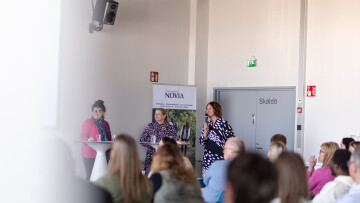
FUI-Bloggen
FUI är förkortningen för forskning, utveckling och innovation. I FUI-bloggen skriver Yrkeshögskolan Novias personal om sitt jobb, forskning, projektverksamhet och andra betraktelser.
Blogginlägg som är granskat av Novias redaktionsråd är utmärkta med nyckelordet "Granskat inlägg".
Vi följer CC-BY 4.0 om inget annat nämns.
Interdisciplinarity is hard, uncomfortable, and definitely worth the effort

Interdisciplinarity is something that evokes either excitement or suspicion. According to the Cambridge Dictionary it means “the fact of involving two or more different subjects or areas of knowledge”. In research and development this means combining for example economics, sociology, health care and environmental science to gain information about something, or to solve a problem.
At the Novia Research Development and Innovation (RDI) seminar in Turku in April, three panelists joined forces to discuss interdisciplinarity: Professor Nina Tynkkynen (Åbo Akademi University), Artist, doctoral researcher and educator Einat Amir (Aalto University) and R&D Coordinator Daniela Mårtenson (Centria UAS). Chairs of the panel were Research Manager Therese Sunngren-Granlund (Novia UAS) and researcher Ruslan Gunko (Åbo Akademi University).
When is interdisciplinarity needed and when not?
Professor Tynkkynen helped us clarify some terms. While disciplinarity means that one academic discipline develops knowledge within that discipline, multidisciplinarity means that multiple disciplines define multiple goals set under the same thematic umbrella. Interdisciplinarity looks more like a spider web, where the disciplines interact with each other and develop integrated knowledge. We are still moving within academic knowledge in all the above-mentioned cases. If we want to mix that knowledge with conventional knowledge from society, we can start talking about transdisciplinary knowledge.
Still with us? Now we know the terminology, but when should we do research within just one discipline and when should we adopt an interdisciplinary approach? It depends very much on the problem we want to solve. If we want to develop a new medicine, it might be best to stick with medicine as the single discipline. When it comes to complex or wicked problems, where there are no straightforward solutions, interdisciplinarity is extremely useful. For example, when gaining knowledge about marine environments and their co-existence with modern society, or developing methods for implementing sustainable technologies, interdisciplinarity is the right way to go.
Interdisciplinarity as a disruptive force
Interdisciplinarity is hard, frustrating, and uncomfortable – and can even be seen as dangerous, said Mårtenson. But it is still worth the effort. It takes time, and collaborations can very well fail. Failures should, however, be a part of the iterative process. They give us the kind of information we don’t see in success stories.
We need to aim high and take risks, Amir encouraged us. She sees interdisciplinarity as a means of dissolving old, outdated dichotomies, like that between art and science. We also need to question our own disciplines’ assumptions by looking at it with the eyes of other disciplines. Everybody joins in equally around the table, regardless of if we are artists or scientists, or what gender or ethnicity we represent.
Going interdisciplinary at Novia RDI
As a conclusion, there are lots of wicked problems, that consist of complex interdependencies: climate change, pandemics, social injustice, and war, to name a few. The only way to approach them is in an interdisciplinary and iterative way. When we are involved in cooperation with other disciplines, we also find new ways to look at ourselves, our own discipline and vocation. At Novia RDI we are aware that we have been too isolated in our own faculties and are constantly working to find ways to cooperate and learn from each other, through shared projects, seminars, and events. The RDI-seminar was a reminder of how important and meaningful that is.
The blogpost has been reviewed by Novia's editorial board and accepted for publication on 15.6.2023.
![]()
FUI-Bloggen
Blogginlägg som är granskat av Novias redaktionsråd är utmärkta med nyckelordet "Granskat inlägg".
Vi följer CC-BY 4.0 om inget annat nämns.
Ansvarsfriskrivning: Författaren/författarna ansvarar för för fakta, möjlig utebliven information och innehållets korrekthet i bloggen. Texterna har genomgått en granskning, men de åsikter som uttrycks är författarens egna och återspeglar inte nödvändigtvis Yrkeshögskolan Novias ståndpunkter.
Disclaimer: The author(s) are responsible for the facts, any possible omissions, and the accuracy of the content in the blog.The texts have undergone a review, however, the opinions expressed are those of the author and do not necessarily reflect the views of Novia University of Applied Sciences.
Posta din kommentar
Kommentarer
Inga har kommenterat på denna sida ännu